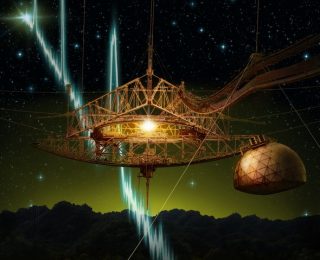by Yvette Cendes | Nov 1, 2014 | Daily Paper Summaries
Title: Limits on low frequency radio emission from southern exoplanetsAuthors: Tara Murphy, et al.First Author Institution: Sydney Institute for Astronomy, The University of Sydney, AustraliaStatus: Accepted for publication in MNRASAstrobites is no stranger to exotic exoplanet discoveries– the Kepler mission alone has increased our knowledge of these worlds by leaps and bounds, and many exciting discoveries have been done by optical telescopes as well through a variety of methods. In today’s paper, however, the authors present results on yet another method of extrasolar planet detection: the possibility of discovering planets in radio frequencies.How does this work? Well we know that planets with high magnetic fields can give of gigantic radio flares in the right circumstances- in our own solar system, Jupiter gives off flares that can be brighter than the sun in radio frequencies thanks to its powerful magnetosphere (which produces bright aurorae like Earth’s magnetosphere- see Figure 1). This is thanks to something called cyclotron maser emission, where electrons from plasma material interact with the magnetic field in a way that beams them like a laser in radio frequencies. In the case of Jupiter, these bursts are visible from Earth when Io– the nearest Galilean moon to Jupiter, which is constantly spewing out material from its volcanoes- is at a particular point in its orbit and this beam of radio radiation is pointed towards us.Of course, if such a thing is a well-documented phenomenon in our own solar system with Jupiter, shouldn’t it also occur around other planets? Astronomers think so, and such flares have been observed from brown dwarfs, but the question is whether these exoplanet radio flares would be strong enough to be detectable from Earth. The answer is “perhaps,” under circumstances such as if the exoplanet is...

by Yvette Cendes | Sep 6, 2014 | Daily Paper Summaries
For the first time, astronomers have announced a Thorne–Żytkow Object candidate- a bizarre system in which a neutron star is surrounded by an envelope of stellar material.
by Yvette Cendes | Jun 13, 2014 | Career Navigation, Personal Experiences
Are you an American interested in applying abroad to Europe for graduate school? Here’s what you need to know!
by Yvette Cendes | May 16, 2014 | Daily Paper Summaries
For the first time ever, signatures from a newly formed moon are spotted in Saturn’s ring system.

by Yvette Cendes | Apr 18, 2014 | Daily Paper Summaries
A mysterious Fast Radio Burst (FRB) from beyond the galaxy has been detected at Arecibo. This is the first FRB discovered outside of Parkes Observatory, giving greater credence to the astronomical nature of these signals.


